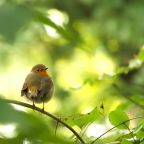
Redrow launches new nature-friendly biodiversity strategy in partnership with The Wildlife Trusts
Leading housebuilder Redrow has launched its ‘Nature for People’ biodiversity strategy, established as part of a long-standing partnership with charity The Wildlife Trusts.
The strategy sees the housebuilder commit to objectives under three key themes - Nature Gains, Rewilding Lives and Flourishing Legacy - including:
- Contributing to existing or potential nature recovery networks so wildlife, including hedgehogs and barn owls, can move freely through their developments and the wider landscape
- Enabling and inspiring community connection with nature
- Measuring the impact on residents’ wellbeing and improvements in nature
- Seeking to exceed government requirements for a 10% biodiversity net gain
- Designing new developments to incorporate and celebrate existing natural features
The strategy launch comes at a time when the links between nature and individual well-being are becoming increasingly widely recognised, with new research from the Mental Health Foundation showing that nearly half of UK adults surveyed who felt stress due to COVID-19 said that being able to visit green spaces helped them cope1.
Nicola Johansen, Group Sustainability Manager at Redrow, comments: “More and more evidence is emerging of the benefits of nature to well-being, particularly in light of the current global pandemic. Throughout lockdown, people have taken solace in the natural environment and we’ve seen first-hand how the pandemic inspired residents across our communities to better connect with nature in their local neighbourhoods and the positive impact it has had on their wellbeing.
“As a leading housebuilder we welcomed Boris Johnson’s speech last week to get Britain building but we found the reference to the natural environment concerning; building more houses and protecting nature doesn’t need to be an ‘either or’ situation. As a housebuilder that strives to enhance and protect the biodiversity in which our communities are situated, we know very well that it is both possible and necessary to do both. Rather than having a ‘Build, Build, Build’ mentality, the industry should consider how it can build better quality and more sustainable homes and communities. Our work with The Wildlife Trusts has helped us begin to enhance our development designs to incorporate and celebrate existing natural features, contribute to nature recovery networks, and explore ways to deliver gains for biodiversity and resident satisfaction, and we are pleased to today share our strategy on how we will achieve that.”
Nature Gains: Connectivity for wildlife
Prior to purchasing land Redrow will assess the wider potential impacts on high-quality habitats in its decision making, and will, in turn, design developments to contribute to existing or potential nature recovery networks. This ‘landscape-led’ design approach means that Redrow will retain existing natural features such as hedgerows, streams and trees and design the new community around them. The aim is to make the most of these natural features to create a great place to live as well as maintaining existing wildlife routes through the development, whilst also creating new routes. It is often the case that wildlife such as foxes, hedgehogs, dormice, barn owls and bats will have established routes through a development. The new approach will ensure these routes are maintained and enhanced, and will ensure that routes traditionally designed for people, such as footpaths, cycle paths and roadside verges, are also designed with wildlife in mind.
This commitment comes as Government also recently announced a Nature Recovery Network Fund, which will partner with businesses and local communities to protect, restore and support existing habitats and wildlife.
Rewilding Lives: Encouraging community participation
The involvement of the community and other organisations, including management companies, in caring for and effectively managing and using natural areas is essential in delivering thriving spaces that are cherished. Redrow will now specify within each of the respective developments’ Community and Nature management plans, how management companies will support community use and requirements for organising community activities and volunteering programmes. Each community will have opportunities to find out about the wildlife and plants that live alongside them. This will be achieved in a variety of ways, from art, home-owner welcome packs and brochures and videos, through to wildlife and cultural trails, community events and volunteering.
Redrow recognises the need for people within developments to come together and share experiences, and so the housebuilder will also provide edible planting and opportunities for community food growing. Eating local produce also promotes a healthy diet, and food for people can also provide fare for wildlife. At Redrow’s Ebbsfleet Green in Kent, which is part of the Edible Ebbsfleet initiative, edible produce has been very popular with residents. Spearheaded by Ebbsfleet Garden City Healthy New Towns, Edible Ebbsfleet provides people of all ages with free access to fruit and vegetables and aims to encourage people to think about where their food comes from. Redrow was the first housebuilder at Ebbsfleet Garden City to support the initiative.
Flourishing Legacy: Effective management
With many habitats taking two or more years to reach their target condition, management plans need to be considered carefully to ensure appropriately resourced and skilled contractors are in place to achieve the net gain result. Therefore, Redrow has pledged to work only with management companies who have a proven track record for delivering positive outcomes for nature and people and share the company’s ambition to deliver a vibrant and natural legacy.
As part of this commitment, Redrow will be considering management implications earlier in the design process of each of its new communities and working collaboratively with management companies to design plans that prioritise biodiversity. Management plans2 are often considered by those implementing them on the ground as overly technical and so, going forward, Redrow’s plans will include clear and straight-forward information for those carrying out the work on the development. In addition, upon purchasing a new home, customers will also receive their own version of the plan, which will overlay the management plan onto a map of their community. This will help residents to fully understand which wildlife habitats are on site and how management companies will be maintaining the space and coordinating community activities.
Nicola Johansen adds: “Our biodiversity strategy, and continued partnership with The Wildlife Trusts, demonstrates how committed Redrow is to creating nature-rich and active communities, and ensuring it plays a role within every function of our business. The next stage of our partnership with The Wildlife Trusts is to develop a rigorous framework that will measure the wellbeing of our residents and the improvements in nature following implementation of our new commitments. With the expertise of The Wildlife Trusts providing us with invaluable, external scrutiny and robustness, we are excited to see how our new commitments improve biodiversity on site and the wellbeing of our residents.”
Peter Dorans, Corporate Relationship Manager, The Wildlife Trusts, said: “We believe that everyone should have the opportunity to experience the joy of wildlife in their daily lives. Daily connection to nature has a profound effect on the health and wellbeing of individuals and communities, and so The Wildlife Trusts are committed to bringing the natural world closer to where we live, work and play.
“Redrow’s strategy and our partnership will enable houses to be built in a way that makes a positive contribution to nature’s recovery and brings people closer to wildlife. It will inspire new residents and communities to access and care about the nature on their doorstep and it will make sure that natural places are looked after forever.
“It is vital that we all, including the Government, look to solutions that help address the loss of nature and climate change, not make it worse. This strategy places Redrow at the vanguard of the housing sector’s response to these twin crises. We hope that together, we can inspire others in the industry to build in a way that is great for people and wildlife.”
The Wildlife Trusts secondment to Redrow
This partnership marks the first time a representative from The Wildlife Trusts has been seconded to a housebuilder, with the aim of developing its biodiversity strategy and objectives.
Over the last 12 months, Rosie Whicheloe, a landscape ecologist from The Wildlife Trusts, has been working with each of Redrow’s teams, from sales consultants through to engineers and design managers, to explain the concept of biodiversity net gain, what the new Department for Environment, Food and Rural Affairs (DEFRA) metric will require from the business and how this will affect work streams and scope of external consultants. Whicheloe’s role was to act as a “critical friend”, identifying what ‘good’ looks like, whilst also highlighting the issues of current practices that need to be addressed and resolved, which resulted in the launch of Redrow’s biodiversity strategy.
Rosie comments: “To enable change, I’ve always believed it’s important to understand the system, straddle across disciplines and get to know how a company works from the inside. Working with companies at the ‘grassroots’ level is very much in line with our focus at The Wildlife Trusts, as we generate the best results through empowering people through knowledge and engagement. That’s why it was so rewarding as an ecologist to be seconded to Redrow. Being able to engage with employees across each of the housebuilder’s regions, including engineers, design managers and planning directors, has formed an important ongoing thread to the strategy as they will be the ones implementing it.”
To read Rosie Whicheloe’s account of her time at Redrow, please visit https://www.redrow.co.uk/newsroom/national/2020/7/redrows-biodiversity-strategy-from-a-wildlife-trust-perspective














